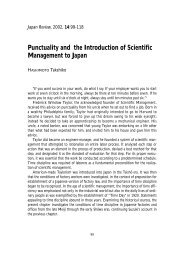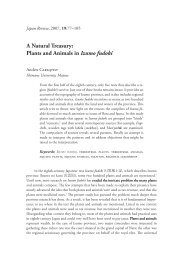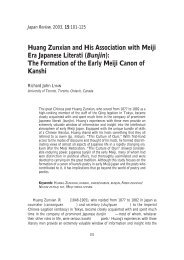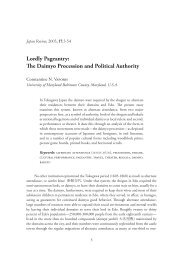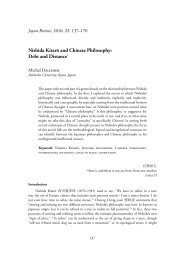Meiji shinkyoku - 国際日本文化研究センター
Meiji shinkyoku - 国際日本文化研究センター
Meiji shinkyoku - 国際日本文化研究センター
Create successful ePaper yourself
Turn your PDF publications into a flip-book with our unique Google optimized e-Paper software.
<strong>Meiji</strong> <strong>shinkyoku</strong>: Th e Beginnings of Modern Music for the Koto<br />
goal was popular appeal. 17 Th e Osaka public found these two works novel, fantastic even and,<br />
judging from the number of compositions that subsequently made use of this scale, the Osaka<br />
composers succeeded admirably in popularising their music.<br />
Th e one thing, however, that oral history does not account for is the disjuncture between<br />
the unmistakably important date of 1868, the year imperial rule was restored, and the mid 1880s<br />
when <strong>Meiji</strong> <strong>shinkyoku</strong> evidently emerged. Neither has there been any academic suggestion to<br />
explain this fi fteen year delay. One possibility is that <strong>Meiji</strong> <strong>shinkyoku</strong> arose as part of the cultural<br />
anxiety that appeared in the 1880s caused by the headlong rush to modernize after Western<br />
models. Th is modernization was forced on the often unwilling populace by the <strong>Meiji</strong> oligarchy.<br />
Seen in this light, this music can be interpreted as an attempt by both producer and consumer<br />
to address the question of what the ‘New Japan’ and its music were to be. Th is in turn would<br />
support the suggestion that the esthetic changes seen in <strong>Meiji</strong> <strong>shinkyoku</strong> represented a shift in<br />
the musicians’ understanding of the relationship between music and consumer, which then<br />
infl uenced their choices as they participated in the formation of a new culture.<br />
In creating a music that would attract a larger audience, Kikutaka fashioned a genre<br />
that fused elements from a variety of diff erent sources, some of which were based in Edo<br />
period practices, while others were taken from the popular music of the time, and still others,<br />
particularly texts, refl ected the popular themes and images of the new age. Th e musical form<br />
Kikutaka used would have posed little in the way of esthetic challenge to the late Edo/early<br />
<strong>Meiji</strong> period audience as it was based on a classic sōkyoku jiuta genre, tegotomono 手事物. At the<br />
same time, the new scale with its reference to minshingaku and the use of two koto rather than<br />
koto and shamisen would have been exciting and diff erent. Th ese early texts addressed themes<br />
with which the <strong>Meiji</strong> audience was intimately familiar, such as civilisation and enlightenment<br />
(bunmei kaika 文明開化) and the emperor (tennō 天皇), or concrete symbols of modernity<br />
such as newspapers. Famous heroes of classical Japan known for their loyalty and sense of duty,<br />
scenic sights of renown, and poetic texts describing seasonal change were also taken up. By the<br />
time of the Sino-Japanese War, and the rise to prominence of Tateyama, these ‘new works’ had<br />
evolved. Some of the characteristics hinted at in the earlier works, nationalism and militarism<br />
in particular, now became extremely pronounced, rendering them even more popular and<br />
attracting students as well as audiences for their performances. 18 Mikuni no homare is indeed<br />
the exemplary early <strong>Meiji</strong> <strong>shinkyoku</strong>, and while it may not contain all the characteristics of the<br />
genre, it nonetheless embodies much of what was to happen during this period.<br />
Th e New Scale: Chinese Popular Music<br />
Th e most immediate musical change in <strong>Meiji</strong> <strong>shinkyoku</strong> was without question the new<br />
scale. While the change was slight—a mere two notes—the impact of the alteration upon<br />
the early <strong>Meiji</strong> listener must have been profound. For Kikutaka modifi ed the fundamental<br />
scale of sōkyoku jiuta and of nearly all Edo-period music, the namely miyako bushi scale. Th is<br />
premodern scale comprise two perfect fourths, a major second apart, commonly referred to as<br />
nuclear tones, which in the example given below (Figure 1 a.) are D–G and A–D, linked to<br />
create an octave. 19 Th e distinct colour of this scale was created by the two notes, each a minor<br />
second above the root of each fourth, E fl at and B fl at. While the B fl at was commonly raised<br />
a major second to C when functioning as a leading tone to the upper D, the lower E fl at was<br />
nonetheless stable and never altered except when modulating temporarily or permanently to<br />
a related key. 20 Kikutaka, however, altered the minor seconds to major seconds, imparting a<br />
107



